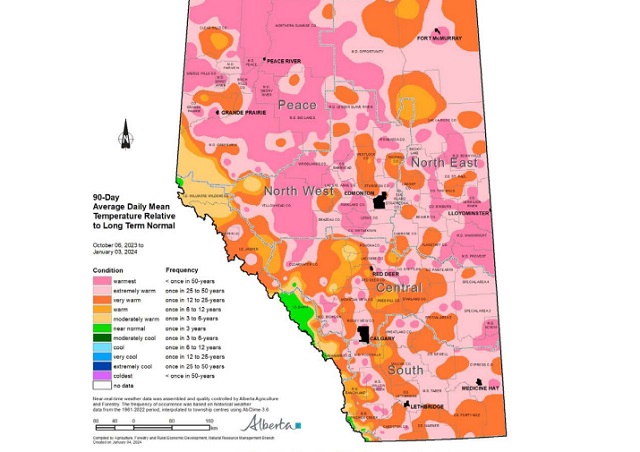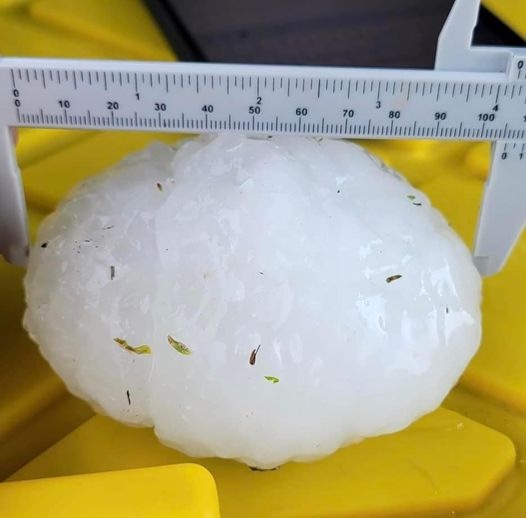weather
Deep freeze envelops Midwest, even stops the mail

BISMARCK, N.D. — A deadly arctic deep freeze enveloped the Midwest with record-breaking temperatures Wednesday, triggering widespread closures of schools and businesses, and prompting the U.S. Postal Service to take the rare step of suspending mail delivery to a wide swath of the region.
Many normal activities shut down and residents huddled inside as the National Weather Service forecast plunging temperatures from one of the coldest air masses in years.
Officials throughout the region were focused on protecting vulnerable people from the cold , including the homeless, seniors and those living in substandard housing. Some buses were turned into mobile warming shelters to help the homeless in Chicago, where temperatures plunged to minus 19 degrees (negative 28 degrees Celsius) early Wednesday, breaking the previous record low for the day set in 1966.
The bitter cold is the result of a split in the polar vortex that allowed temperatures to plunge much further south than normal.
Governors in Illinois, Wisconsin and Michigan declared emergencies as the worst of the cold threatened on Wednesday. In Chicago, major attractions closed because of the bitter cold, including the Lincoln Park Zoo, the Art Institute and the Field Museum.
“These (conditions) are actually a public health risk and you need to treat it appropriately,” Chicago Mayor Rahm Emanuel said Tuesday. “They are life-threatening conditions and temperatures.”
A wind chill of minus 25 (negative 32 degrees Celsius) can freeze skin within 15 minutes, according to the National Weather Service.
In Michigan, homeless shelters in Lansing were becoming “overloaded,” Mayor Andy Schor said. They also were filling up in Detroit.
“People don’t want to be out there right now,” said Brennan Ellis, 53, who is staying at the Detroit Rescue Mission Ministries.
Detroit’s outlook was for Wednesday overnight lows around minus 12 (negative 24 degrees Celsius), with wind chills dropping to minus 35 (negative 37 degrees Celsius).
At least four deaths were linked to the weather system Tuesday, including a man struck and killed by a snow plow in the Chicago area, a young couple whose SUV struck another on a snowy road in northern Indiana and a Milwaukee man found frozen to death in a garage.
A popular saying goes: “Neither snow nor rain nor heat …” will stop the mail from being delivered. But extreme cold will on Wednesday.
The U.S. Postal Service said it would suspend mail delivery on Wednesday in parts or all of several Midwest states including North Dakota, South Dakota, Nebraska, Kansas, Minnesota, Wisconsin, Iowa, Illinois, Indiana and Michigan.
Hawaii native Charles Henry, 54, was staying at a shelter in St. Paul, Minnesota, and said he was grateful to have a place to stay out of the cold.
“That wind chill out there is not even a joke,” he said. “I feel sorry for anybody that has to stay outside.”
Chicago was turning five buses into makeshift warming
“We’re bringing the warming shelters to them, so they can stay near all of their stuff and still warm up,” said Cristina Villarreal, spokeswoman for the city’s Department of Family and Support Services.
Shelters, churches and city departments in Detroit worked together to help get vulnerable people out of the cold, offering the message to those who refused help that “you’re going to freeze or lose a limb,” said Terra DeFoe, a senior adviser to Detroit Mayor Mike Duggan.
Hundreds of public schools and several large universities from North Dakota to Pennsylvania
American Indian tribes in the Upper Midwest were doing what they could to help members in need with heating supplies. The extreme cold was “a scary situation,” because much of the housing is of poor quality, said Chris Fairbanks, energy assistance program manager for the White Earth Band of Ojibwe in Minnesota.
The cold weather was even affecting beer deliveries, with a pair of western Wisconsin distributors saying they would delay or suspend shipments for fear that beer would freeze in their trucks.
But it wasn’t stopping one of America’s most formidable endurance tests, however — the three-day Arrowhead 135 was going on as scheduled in northeastern Minnesota. Competitors can cover the race route by bicycle, cross-country skis or just running.
The cold is attributed to a sudden warming far above the North Pole. A blast of warm air from misplaced Moroccan heat last month made the normally super chilly air temperatures above the North Pole rapidly increase. That split the polar vortex into pieces, which then started to wander, said Judah Cohen, a winter storm expert for Atmospheric Environmental Research.
One of those polar vortex pieces is responsible for the subzero temperatures across the Midwest this week.
___
Associated Press reporters Caryn Rousseau and Don Babwin in Chicago; Corey Williams, David Runk and Mike Householder in Detroit; David Eggert in Lansing, Michigan; and Jeff Baenen in Minneapolis contributed to this report. AP Science Writer Seth Borenstein also contributed.
Blake Nicholson, The Associated Press
Agriculture
Moisture situation in Alberta following warm and dry first half of winter

Agricultural Moisture Situation Update – January 3, 2024
Synopsis
This year’s El Niño has developed into a strong El Niño and currently has a 54% chance of developing into a “historically strong” event, according to NOAA. Current forecasts are projecting El Niño to diminish in April 2024. In the past for Alberta, not all El Niño’s have resulted in warmer and drier weather; however, this unusually warm and dry winter will forever be tied to the 2023-2024 El Niño and will serve as an important data point in the future.
In the 90-days since October 6, 2023, temperatures have remained well above average, with many parts of the northern-half of the province seeing temperatures this warm less than once in 50 years (Map 1). This coupled with low precipitation accumulations has resulted in virtually snow free
conditions across parts of all four of our agricultural regions
(Map 2).
Winter Precipitation Accumulations
November 1, 2023 to January 3, 2024
Since November 1st, the unofficial start to winter in Alberta, precipitation has been well below average across much of Alberta’s agricultural areas (Map 3).

Most of the lands south of Grande Prairie and north of Ponoka are estimated to have a winter thus far, this dry on average, less than once in 50-years. Dry conditions have also persisted across the Central and Southern Regions, ranging from a few widely scattered pockets of near normal to at least once in 25 year lows, centered around the Jenner area (approx. 200 km east of Calgary). Total accumulations currently range from less than 3 mm through parts of the North West and North East Regions up to only 20-30 mm along the foothills and through the western and northern portions of the Peace Region (Map 4).

For the dryer parts of the North West and North East Regions this translates to less than 10% of the 1991-2020 average (Map 5).

Elsewhere, most other lands have received precipitation accumulations that have generally been less
than 50% of the 1991-2020 average.
Perspective
From an annual moisture budget perspective, October through to March generally mark the dry season across the agricultural areas (Map 6), accounting for only about 20% of average annual accumulations across most of the Southern Region, to upwards of 30-35% across the Peace Region.

These significant moisture deficits thus far (50% of the way through the dry season), while discouraging to many, make up only a small portion of the annual moisture budget for an area. Winter is not over yet and if the current forecast is correct, a significant cold snap is on its way over the next few days and it is expected to persist well into next week, perhaps even longer. Along with the cold snap, there is also a forecast for moisture and the promise of at least some snow cover across many areas.
Spring is yet many weeks away and anything can happen between now and then. Furthermore, February on average, is the driest month of the year with most agricultural lands normally receiving less than 15 mm of moisture during this month (Map 6). Let’s hope, for the sake of our producers,
that we descend into at least near “normal” winter conditions and that we see one of Alberta’s famous weather reversals, with respect to moisture. Above average snow fall is very much needed now. Much of the land is extremely dry and has been held tenaciously in the grip of a long-lasting dry
cycle that needs to end soon!
Alberta
With hail storms this size it’s a miracle no one was killed

Monday, August 1st will be a day hundreds of Albertans will never forget. The hail storm that devastated an area of Central Alberta resulted in a series of terrifying experiences for motorists on the QE II, especially around Antler Hill, just north of Innisfail. This is a map of the area most affected by the largest hail stones most have seen in their lifetimes.

Yes we’ve all heard people talk about “baseball” or “tennis ball” sized hail in the past. In this case, those comparisons are simply too small!


Now you can imagine how terrifying it must have been to be caught driving on the QE II south of Red Deer and north of Innisfail during this storm on Monday, August 1st. Here’s what that felt like, courtesy of Gibran Marquez as posted on the Facebook Page Alberta Storm Reports
This couple was remarkably calm considering the battering they were experiencing!
The immediate aftermath.
-

 Frontier Centre for Public Policy2 days ago
Frontier Centre for Public Policy2 days agoThe tale of two teachers
-

 Business1 day ago
Business1 day agoMaxime Bernier warns Canadians of Trudeau’s plan to implement WEF global tax regime
-

 COVID-1921 hours ago
COVID-1921 hours agoWHO Official Admits the Truth About Passports
-

 International16 hours ago
International16 hours agoUN attacks stay-at-home motherhood as ‘gender inequality’
-

 Alberta17 hours ago
Alberta17 hours agoProvince to stop municipalities overcharging on utility bills
-

 Freedom Convoy24 hours ago
Freedom Convoy24 hours agoOttawa spent “excessive” $2.2 million fighting Emergencies Act challenge
-

 Energy16 hours ago
Energy16 hours agoAnti-LNG activists have decided that they now actually care for LNG investors after years of calling to divest
-

 Alberta1 day ago
Alberta1 day agoAlberta moves to protect Edmonton park from Trudeau government’s ‘diversity’ plan







